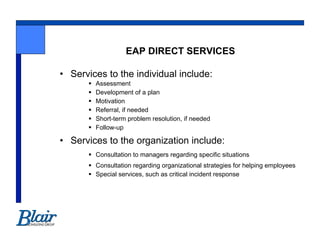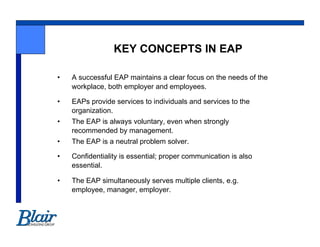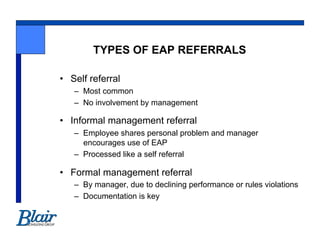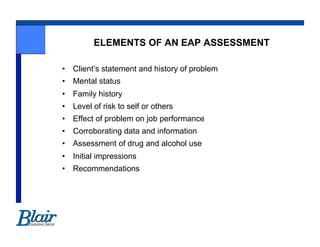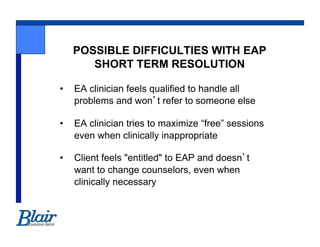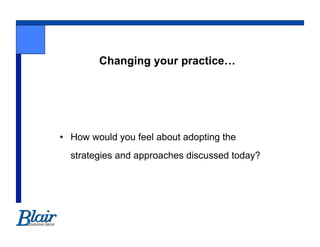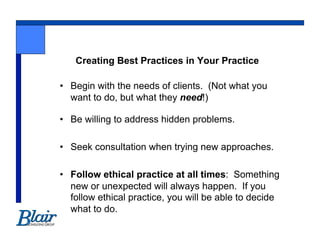B blair hot eapa 2013
- 1. Implementing EAP Best Practices: Thoughts for Clinicians Brenda R. Blair, MBA, CEAP March 1, 2013, Austin, Texas P.O. Box 9927, College Station, TX 77842 email: blairconsultants.com Web information: www.blairconsultants.com
- 2. EAP DIRECT SERVICES • Services to the individual include: Assessment Development of a plan Motivation Referral, if needed Short-term problem resolution, if needed Follow-up • Services to the organization include: Consultation to managers regarding specific situations Consultation regarding organizational strategies for helping employees Special services, such as critical incident response
- 3. KEY CONCEPTS IN EAP • A successful EAP maintains a clear focus on the needs of the workplace, both employer and employees. • EAPs provide services to individuals and services to the organization. • The EAP is always voluntary, even when strongly recommended by management. • The EAP is a neutral problem solver. • Confidentiality is essential; proper communication is also essential. • The EAP simultaneously serves multiple clients, e.g. employee, manager, employer.
- 4. EAPs Serve Multiple clients • Employee (and/or family member) • Sponsoring organization (employer, union) • Supervisor / manager • HR • Occupational Health • Labor union • Safety / Security • Larger community in general
- 5. TYPES OF EAP REFERRALS • Self referral – Most common – No involvement by management • Informal management referral – Employee shares personal problem and manager encourages use of EAP – Processed like a self referral • Formal management referral – By manager, due to declining performance or rules violations – Documentation is key
- 6. Looking for Best Practices • How is an EAP assessment different from a general clinical assessment?
- 7. Importance of Assessment • Client may have never sought counseling before • Client may not understand what he/she needs • Workplace issues may be part of the concern • Multiple people may be involved with this client’s concerns • Client may be intimidated by the health care system • Client may have concerns about the cost of treatment • Solutions may or may not involve counseling
- 8. ELEMENTS OF AN EAP ASSESSMENT • Client’s statement and history of problem • Mental status • Family history • Level of risk to self or others • Effect of problem on job performance • Corroborating data and information • Assessment of drug and alcohol use • Initial impressions • Recommendations
- 9. An EAP Assessment…. • Is usually more directive • Leads more quickly to a specific action plan • Must be efficient • Involves a different kind of therapeutic rapport • Feels like a triage, more screening questions • Always considers the workplace • Requires more analysis of implications
- 10. Looking for Best Practices • How is an EAP action plan different from a treatment plan?
- 11. DEVELOPING AN ACTION PLAN • In partnership with client • Identify and prioritize problems • Set realistic, attainable goals/timeframes • Lists all resources to meet goals - EAP - HR - Occupational Health - Employee s supervisor - Treatment resource - Community resources/support groups - Educational resources - Web-based resources/support groups
- 12. POSSIBLE DIFFICULTIES WITH EAP SHORT TERM RESOLUTION • EA clinician feels qualified to handle all problems and won t refer to someone else • EA clinician tries to maximize “free” sessions even when clinically inappropriate • Client feels "entitled" to EAP and doesn t want to change counselors, even when clinically necessary
- 13. Educating the Client About Short-Term Problem Resolution • Important to clarify the EAP role • Involve the client in the decision-making • Explain clinical rationale for recommendations outside of EAP • Offer follow-up and continuing contact through EAP
- 14. Looking for Best Practices • How is a EAP follow-up different and what do EAP companies expect of network clinicians?
- 15. EAP Follow-up • Critical to client success • Involves more communication • A different view of confidentiality • Greater collaboration with the EAP company that made the referral to the clinician • May last longer or have different content
- 16. Looking for Best Practices • How are EAP management referrals different?
- 17. Management Referrals: High Value Cases • Based on a workplace issue, so company is vitally interested in the outcome • May be complicated cases involving psychiatric illness, addictions, violence, or fitness issues • Will require active communication with the EAP company that made the referral • Clinician’s interaction with client may be more assertive and directive • Clinician must avoid being an “advocate” for one side but must emphasize problem resolution
- 18. Changing your practice… • How would you feel about adopting the strategies and approaches discussed today?
- 19. Some obstacles and possible ways to overcome • I’m not comfortable talking directly about certain subjects. -- If we can speak comfortably about everything, we give our clients permission to do so. • I believe in letting the client lead the process. -- If we offer different ways of considering a situation, we allow the client more choices.
- 20. Some obstacles and possible ways to overcome • That’s not how I was trained. -- If we ask our clients to change, should we not also be open to change? Especially if it helps our clients!
- 21. Creating Best Practices in Your Practice • Begin with the needs of clients. (Not what you want to do, but what they need!) • Be willing to address hidden problems. • Seek consultation when trying new approaches. • Follow ethical practice at all times: Something new or unexpected will always happen. If you follow ethical practice, you will be able to decide what to do.
- 22. Contact Information Brenda Blair President, Blair Consulting Group, Inc. PO Box 9927 College Station, TX 77842 979-693-7268 bblair@blairconsultants.com www.blairconsultants.com

